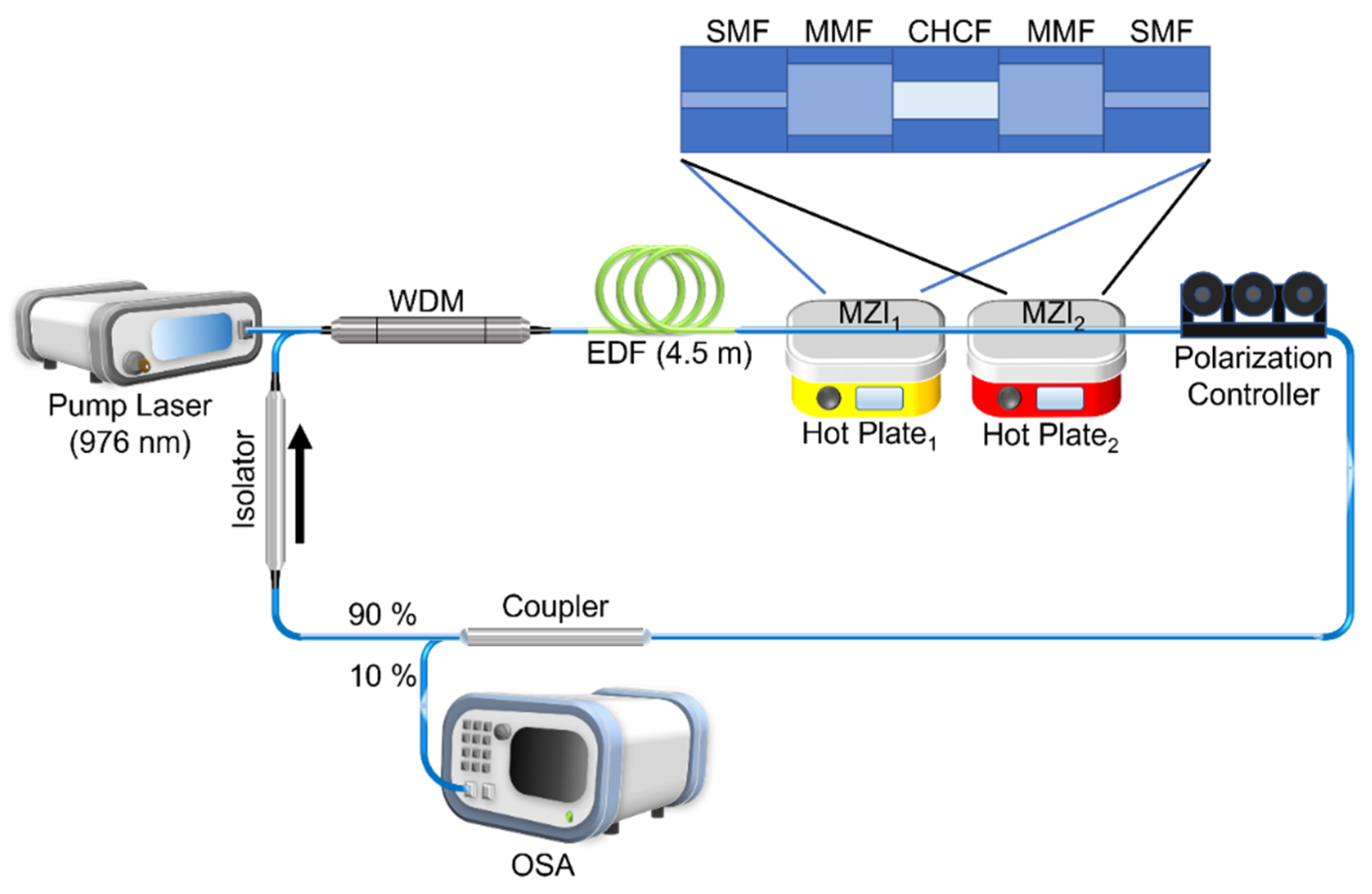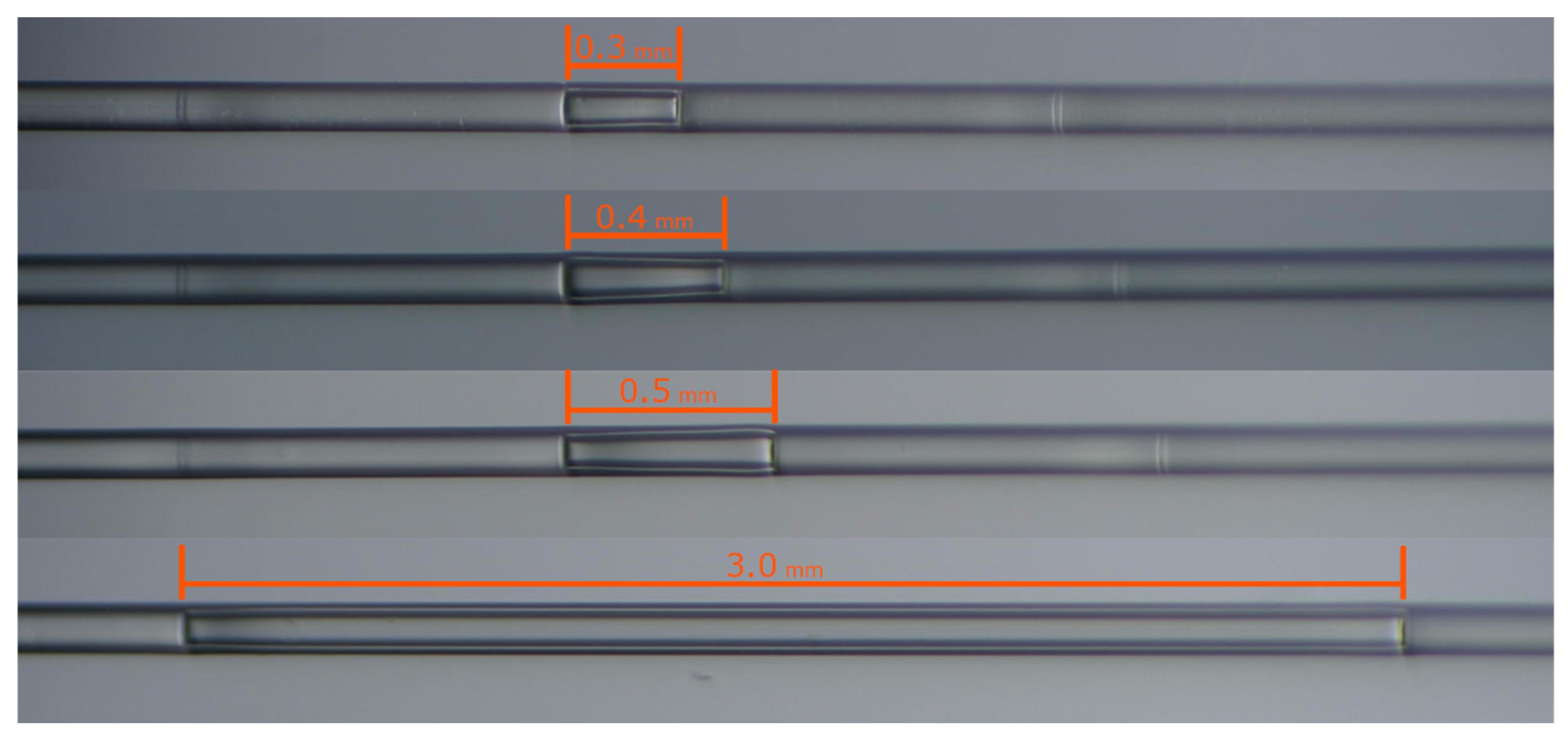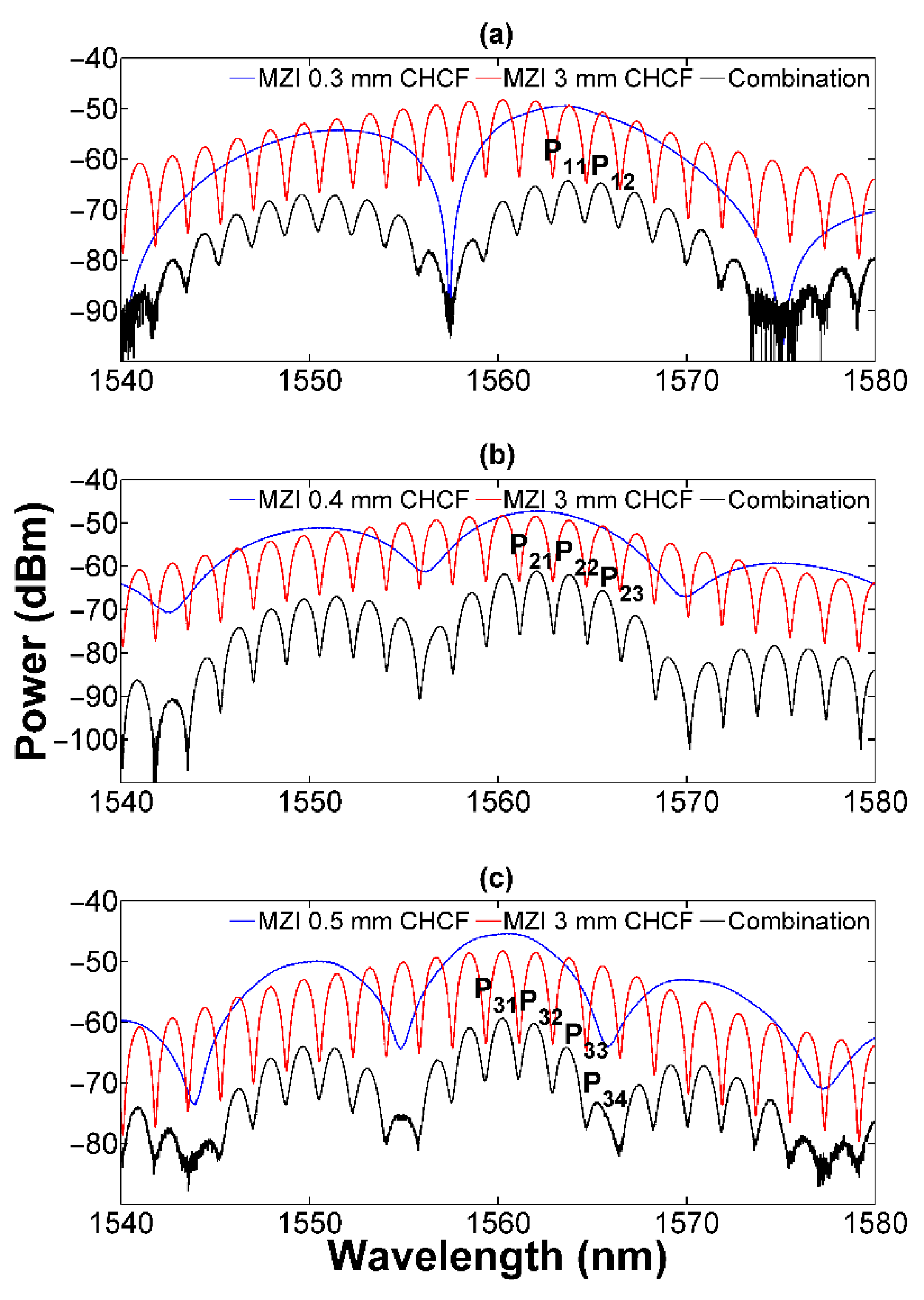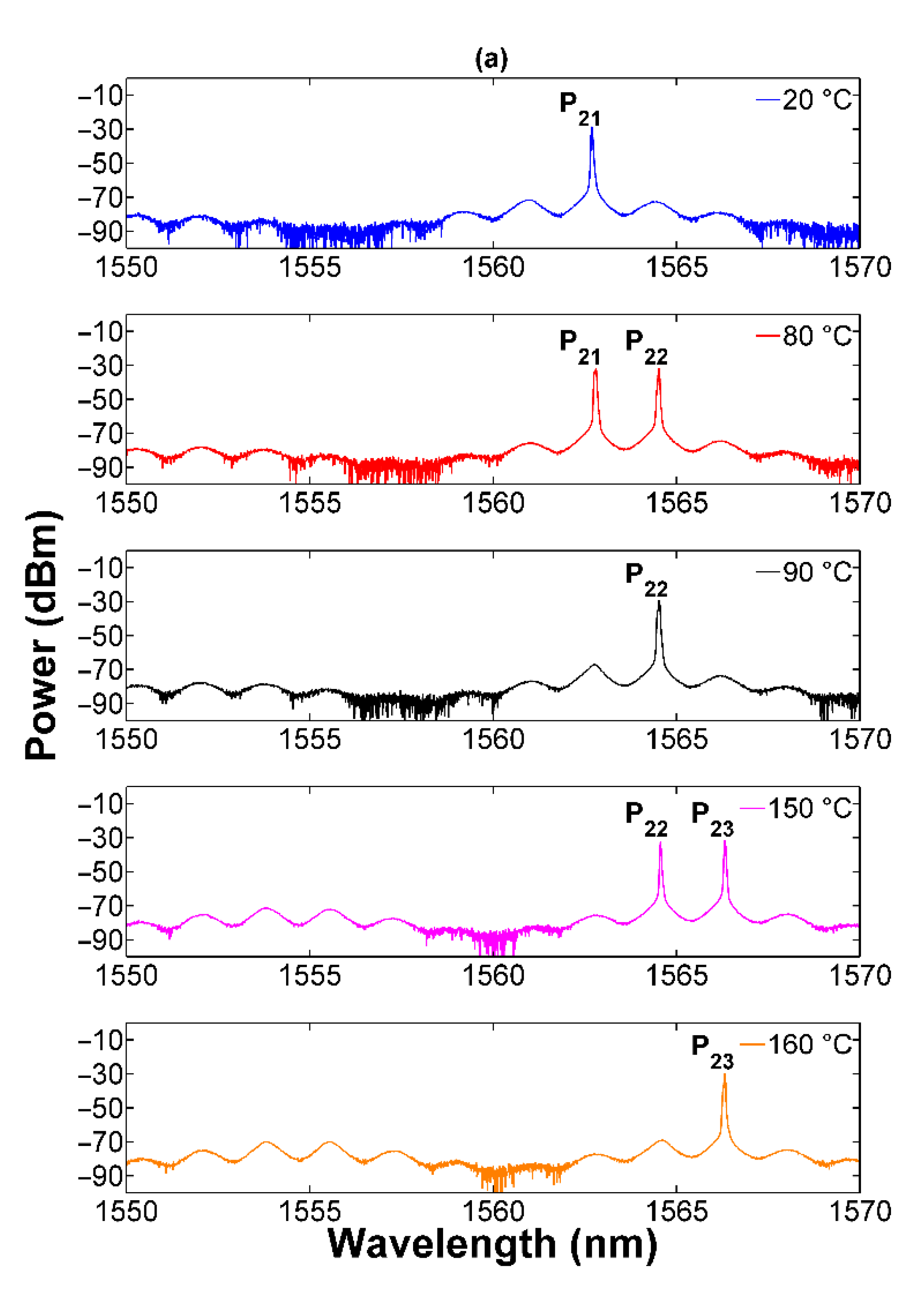Highly Stable Switchable Emissions of an Erbium-Doped Fiber Ring Laser Using Cascaded MZIs Based on CHCF
Abstract
:1. Introduction
2. Materials and Methods
Fabrication Process and Working Principle
3. Results
3.1. MZI2 and MZI1a in a Cascade Configuration
3.2. MZI2 and MZI1b in a Cascade Configuration
3.3. MZI2 and MZI1c in a Cascade Configuration
4. Discussion
5. Conclusions
Author Contributions
Funding
Data Availability Statement
Acknowledgments
Conflicts of Interest
References
- Lee, S.-M.; Choi, K.-M.; Mun, S.-G.; Moon, J.-H.; Lee, C.-H. WDM-PON Based on Wavelength-Locked Fabry-Pe/Spl Acute/Rot Laser Diodes. IEEE Photon. Technol. Lett. 2005, 17, 1579–1581. [Google Scholar] [CrossRef]
- Al-Mashhadani, M.K.S.; Al-Mashhadani, T.F.; Goktas, H.H. Broadly Tunable 40 GHz Brillouin Frequency Spacing Multiwavelength Brillouin–Erbium Fiber Laser for DWDM. Opt. Commun. 2019, 451, 116–123. [Google Scholar] [CrossRef]
- Diaz, S.; Lopez-Amo, M. Dual-Wavelength Single-Longitudinal-Mode Erbium Fiber Laser for Temperature Measurements. Opt. Eng. 2014, 53, 036106. [Google Scholar] [CrossRef] [Green Version]
- Li, Y.; Zhou, C.; Tian, J.; Ji, S.; Yao, Y. An All-Fiber Multi-Channel Ultrasonic Sensor Using a Switchable Fiber Bragg Gratings Filter in Erbium-Doped Fiber Laser. J. Light. Technol. 2019, 37, 4330–4339. [Google Scholar] [CrossRef]
- Ahmad, N.A.B.; Dahlan, S.H.; Jamaluddin, M.H.; Sanchez-Lara, R.; Cholan, N.A. A Microwave Signal Generation Technique Based on Brillouin-Erbium Fiber Laser. Int. J. Integr. 2019, 11, 33–38. [Google Scholar] [CrossRef] [Green Version]
- Kumar, A.; Gautam, A.; Priye, V. Microwave Photonic Mixer Using DP-DDMZM for Next Generation 5G Cellular Systems. Fiber Integr. Opt. 2020, 39, 149–168. [Google Scholar] [CrossRef]
- Moon, D.S.; Paek, U.-C.; Chung, Y. Multi-Wavelength Lasing Oscillations in an Erbium-Doped Fiber Laser Using Few-Mode Fiber Bragg Grating. Opt. Express 2004, 12, 6147. [Google Scholar] [CrossRef] [PubMed]
- Liu, Y.; Dong, X.; Shum, P.; Yuan, S.; Kai, G.; Dong, X. Stable Room-Temperature Multi-Wavelength Lasing Realization in Ordinary Erbium-Doped Fiber Loop Lasers. Opt. Express 2006, 14, 9293. [Google Scholar] [CrossRef]
- Chen, W.G.; Lou, S.Q.; Feng, S.C.; Wang, L.W.; Li, H.L.; Guo, T.Y.; Jian, S.S. Switchable Multi-Wavelength Fiber Ring Laser Based on a Compact in-Fiber Mach-Zehnder Interferometer with Photonic Crystal Fiber. Laser Phys. 2009, 19, 2115–2119. [Google Scholar] [CrossRef]
- He, W.; Zhu, L.; Meng, F.; Song, Y.; Dong, M. Selectable and Stable C-Band Multi-Wavelength Ring Cavity Erbium-Doped Fiber Laser Employing Sagnac Loop and Tunable Filter. Optik 2019, 176, 528–534. [Google Scholar] [CrossRef]
- He, W.; Zhu, L.; Dong, M.; Lou, X.; Luo, F. Wavelength-Switchable C-Band Erbium-Doped Fibre Laser Incorporating All-Fibre Fabry–Perot Interferometer Fabricated by Chemical Etching. J. Mod. Opt. 2018, 65, 818–824. [Google Scholar] [CrossRef]
- Martin-Vela, J.A.; Sierra-Hernandez, J.M.; Gallegos-Arellano, E.; Estudillo-Ayala, J.M.; Bianchetti, M.; Jauregui-Vazquez, D.; Reyes-Ayona, J.R.; Silva-Alvarado, E.C.; Rojas-Laguna, R. Switchable and Tunable Multi-Wavelength Fiber Laser Based on a Core-Offset Aluminum Coated Mach-Zehnder Interferometer. Opt. Laser Technol. 2020, 125, 106039. [Google Scholar] [CrossRef]
- Tang, Z.; Liu, L.; Benson, T.; Lian, Z.; Lou, S. Dual-Wavelength Interval Tunable and Multi-Wavelength Switchable High-Performance Fiber Laser Based on Four-Leaf Clover Suspended Core Fiber Filter. Opt. Laser Technol. 2021, 139, 106966. [Google Scholar] [CrossRef]
- Chang, Y.; Pei, L.; Wang, J.; Zheng, J.; Ning, T.; Li, J.; Xie, C. Highly Stable Multi-Wavelength Fiber Laser Based on Hybrid Enclosed Two-Armed Fiber Filter. Opt. Fiber Technol. 2022, 71, 102894. [Google Scholar] [CrossRef]
- Huang, B.; Sheng, X.; Tang, Z.; Lou, S. High SMSR and Widely Tunable Multi-Wavelength Erbium Doped Fiber Laser Based on Cascaded Filters. Infrared Phys. Technol. 2022, 122, 104082. [Google Scholar] [CrossRef]
- Liu, X.; Zhan, L.; Luo, S.; Wang, Y.; Shen, Q. Individually Switchable and Widely Tunable Multiwavelength Erbium-Doped Fiber Laser Based on Cascaded Mismatching Long-Period Fiber Gratings. J. Light. Technol. 2011, 29, 3319–3326. [Google Scholar] [CrossRef]
- Silva-Alvarado, E.C.; Martinez-Rios, A.; Gallegos-Arellano, E.; Martin-Vela, J.A.; Ledesma-Carrillo, L.M.; Reyes-Ayona, J.R.; Porraz-Culebro, T.E.; Sierra-Hernandez, J.M. Tunable Filter Based on Two Concatenated Symmetrical Long Period Fiber Gratings as Mach-Zehnder Interferometer and Its Fiber Lasing Application. Opt. Laser Technol. 2022, 149, 107824. [Google Scholar] [CrossRef]
- Wang, F.; Xu, E.-M.; Dong, J.-J.; Zhang, X.-L. A Tunable and Switchable Single-Longitudinal-Mode Dual-Wavelength Fiber Laser Incorporating a Reconfigurable Dual-Pass Mach–Zehnder Interferometer and Its Application in Microwave Generation. Opt. Commun. 2011, 284, 2337–2340. [Google Scholar] [CrossRef]
- Wei, H.; Lianqing, Z.; Mingli, D. All-Fiber Mach–Zehnder Comb Filter Based on Tapered Fibers for Wavelength Switchable Erbium-Doped Fiber Lasers. Int. J. Optomechatron. 2020, 14, 18–28. [Google Scholar] [CrossRef]
- Zhao, Q.; Pei, L.; Tang, M.; Xie, Y.; Ruan, Z.; Zheng, J.; Ning, T. Switchable Multi-Wavelength Erbium-Doped Fiber Laser Based on Core-Offset Structure and Four-Wave-Mixing Effect. Opt. Fiber Technol. 2020, 54, 102111. [Google Scholar] [CrossRef]
- Zhao, Q.; Pei, L.; Zheng, J.; Tang, M.; Xie, Y.; Li, J.; Ning, T. Switchable, Widely Tunable and Interval-Adjustable Multi-Wavelength Erbium-Doped Fiber Laser Based on Cascaded Filters. J. Light. Technol. 2020, 38, 2428–2433. [Google Scholar] [CrossRef]
- Zou, H.; Lou, S.; Yin, G.; Su, W. Switchable Dual-Wavelength PM-EDF Ring Laser Based on a Novel Filter. IEEE Photon. Technol. Lett. 2013, 25, 1003–1006. [Google Scholar] [CrossRef]
- Lv, Y.; Lou, S.; Tang, Z.; Liu, X.; Wang, X. Tunable C-Band and L-Band Multi-Wavelength Erbium-Doped Fiber Ring Laser Based on a Triple-Core Photonic Crystal Fiber with Polarization-Dependent Loss. Opt. Laser Technol. 2020, 128, 106269. [Google Scholar] [CrossRef]
- Qi, Y.; Kang, Z.; Sun, J.; Ma, L.; Jin, W.; Lian, Y.; Jian, S. Wavelength-Switchable Fiber Laser Based on Few-Mode Fiber Filter with Core-Offset Structure. Opt. Laser Technol. 2016, 81, 26–32. [Google Scholar] [CrossRef]
- Tang, Z.; Lou, S.; Wang, X. Stable and Widely Tunable Single-/Dual-Wavelength Erbium-Doped Fiber Laser by Cascading a Twin-Core Photonic Crystal Fiber Based Filter with Mach-Zehnder Interferometer. Opt. Laser Technol. 2019, 109, 249–255. [Google Scholar] [CrossRef]
- He, W.; Yuan, H.; Lou, X.; Zhu, L.; Dong, M. Multi-Wavelength Switchable Erbium-Doped Fiber Laser Based on a Hybrid Filter Incorporating a Bi-Tapered Mach–Zehnder Interferometer and Sagnac Loop. Phys. Scr. 2019, 94, 125502. [Google Scholar] [CrossRef]
- Chang, Y.; Pei, L.; Ning, T.; Zheng, J.; Li, J.; Xie, C. Switchable and Tunable Multi-Wavelength Fiber Ring Laser Employing a Cascaded Fiber Filter. Opt. Fiber Technol. 2020, 58, 102240. [Google Scholar] [CrossRef]
- Zhang, L.; Tian, Z.; Chen, N.-K.; Han, H.; Liu, C.-N.; Grattan, K.T.V.; Rahman, B.M.A.; Zhou, H.; Liaw, S.-K.; Bai, C. Room-Temperature Power-Stabilized Narrow-Linewidth Tunable Erbium-Doped Fiber Ring Laser Based on Cascaded Mach-Zehnder Interferometers with Different Free Spectral Range for Strain Sensing. J. Light. Technol. 2020, 38, 1966–1974. [Google Scholar] [CrossRef]
- Filoteo-Razo, J.D.; Hernandez-Garcia, J.C.; Estudillo-Ayala, J.M.; Pottiez, O.; Jauregui-Vazquez, D.; Sierra-Hernandez, J.M.; Lauterio-Cruz, J.P.; Carrillo-Delgado, C.M.; Rojas-Laguna, R. Multi-Wavelength Er–Yb-Doped Fibre Ring Laser Using a Double-Pass Mach–Zehnder Interferometer with a Sagnac Interferometer. Opt. Laser Technol. 2021, 139, 106994. [Google Scholar] [CrossRef]
- Xin, L.; Zhou, X.; Chen, J. Low Threshold Multi-Wavelength Erbium-Doped Fiber Ring Laser with NOLM and Lyot Filter. Opt. Fiber Technol. 2022, 68, 102800. [Google Scholar] [CrossRef]
- Marrujo-García, S.; Hernández-Romano, I.; May-Arrioja, D.A.; Minkovich, V.P.; Torres-Cisneros, M. In-Line Mach–Zehnder Interferometers Based on a Capillary Hollow-Core Fiber Using Vernier Effect for a Highly Sensitive Temperature Sensor. Sensors 2021, 21, 5471. [Google Scholar] [CrossRef] [PubMed]
- Marrujo-García, S.; Herrera-Piad, L.A.; Hernández-Romano, I.; May-Arrioja, D.A.; Minkovich, V.P.; Torres-Cisneros, M. Narrow Spectral Linewidth and Tunable Erbium-Doped Fiber Ring Laser Using a MZI Based on CHCF. Opt. Fiber Technol. 2021, 67, 102739. [Google Scholar] [CrossRef]








| Experimental FSR (nm) | Calculated Length * (mm) | Designed CHCF Length (mm) | Error (%) | Contrast (dB) | |
|---|---|---|---|---|---|
| MZI1a | 17.8 | 0.304 | 0.3 | 1.33 | 42.2 |
| MZI1b | 13.3 | 0.407 | 0.4 | 1.75 | 19.7 |
| MZI1c | 11.0 | 0.493 | 0.5 | 1.40 | 19.0 |
| MZI2 | 1.8 | 2.942 | 3 | 1.93 | 15.4 |
| Cascaded MZIs | Peak | Wavelength (nm) |
|---|---|---|
| MZI2 and MZI1a | P11 | 1563.7 |
| P12 | 1565.5 | |
| MZI2 and MZI1b | P21 | 1562.7 |
| P22 | 1564.5 | |
| P23 | 1566.3 | |
| MZI2 and MZI1c | P31 | 1560.0 |
| P32 | 1561.8 | |
| P33 | 1563.6 | |
| P34 | 1565.4 |
| Cascaded MZIs | Temperature (°C) | Single-Wavelength Laser Emission (nm) | Dual-Wavelength Laser Emission | SNR (dB) |
|---|---|---|---|---|
| MZI2 and MZI1a | 20–29 | P11 (1563.7) | 58.9 | |
| 30–39 | P11 and P12 | 58.9 and 58.6 | ||
| 40–160 | P12 (1565.5) | 58.6 | ||
| MZI2 and MZI1b | 20–79 | P21 (1562.7) | 50.3 | |
| 80–89 | P21 and P22 | 50.3 and 50.9 | ||
| 90–149 | P22 (1564.5) | 50.9 | ||
| 150–159 | P22 and P23 | 50.9 and 50.8 | ||
| 160 | P23 (1566.3) | 50.8 | ||
| MZI2 and MZI1c | 20–29 | P31 (1560.0) | 54.5 | |
| 30–39 | P31 and P32 | 54.5 and 54.7 | ||
| 40–89 | P32 (1561.8) | 54.7 | ||
| 90–99 | P32 and P33 | 54.7 and 54.2 | ||
| 100–149 | P33 (1563.6) | 54.2 | ||
| 150–159 | P33 and P34 | 54.2 and 55.1 | ||
| 160 | P34 (1565.4) | 55.1 |
| No. | Structure | Switchable Lines | SMSR/NSR | Linewidth |
|---|---|---|---|---|
| 1 [26] | MZI (bi-tapered) and Sagnac (Coupler) | 5 | NA/>14.98 dB | NA |
| 2 [10] | Sagnac (coupler) and Filter (PMF) | 3 | NA/23 dB | <600 pm |
| 3 [25] | MZI (coupler) and Filter (TCPCF) | 2 | >45 dB/NA | 26 pm |
| 4 [28] | MZI (coupler) and MZI (TSCF) | 1 | 45 dB/NA | 17.1 pm |
| 5 [27] | Filter (SE-HSOFF) and Sagnac (coupler) | 4 | NA/>30 dB | NA |
| 6 [29] | MZI (Coupler) and Sagnac (Coupler) | 5 | 48.7 dB/NA | 60 pm |
| 7 [30] | NOLM (Coupler) and Filter (Lyot) | 23 | >25 dB/NA | 500 pm |
| 8 [13] | Filter (FLCSCF) | 6 | NA/>50 dB | 20 pm |
| This work | MZI (CHCF) and MZI (CHCF) | 2 | NA/58.9 dB | 30 pm |
Publisher’s Note: MDPI stays neutral with regard to jurisdictional claims in published maps and institutional affiliations. |
© 2022 by the authors. Licensee MDPI, Basel, Switzerland. This article is an open access article distributed under the terms and conditions of the Creative Commons Attribution (CC BY) license (https://creativecommons.org/licenses/by/4.0/).
Share and Cite
Herrera-Piad, L.A.; Marrujo-García, S.; Hernández-Romano, I.; May-Arrioja, D.A.; Minkovich, V.P.; Torres-Cisneros, M. Highly Stable Switchable Emissions of an Erbium-Doped Fiber Ring Laser Using Cascaded MZIs Based on CHCF. Machines 2022, 10, 962. https://doi.org/10.3390/machines10100962
Herrera-Piad LA, Marrujo-García S, Hernández-Romano I, May-Arrioja DA, Minkovich VP, Torres-Cisneros M. Highly Stable Switchable Emissions of an Erbium-Doped Fiber Ring Laser Using Cascaded MZIs Based on CHCF. Machines. 2022; 10(10):962. https://doi.org/10.3390/machines10100962
Chicago/Turabian StyleHerrera-Piad, Luis A., Sigifredo Marrujo-García, Iván Hernández-Romano, Daniel A. May-Arrioja, Vladimir P. Minkovich, and Miguel Torres-Cisneros. 2022. "Highly Stable Switchable Emissions of an Erbium-Doped Fiber Ring Laser Using Cascaded MZIs Based on CHCF" Machines 10, no. 10: 962. https://doi.org/10.3390/machines10100962





